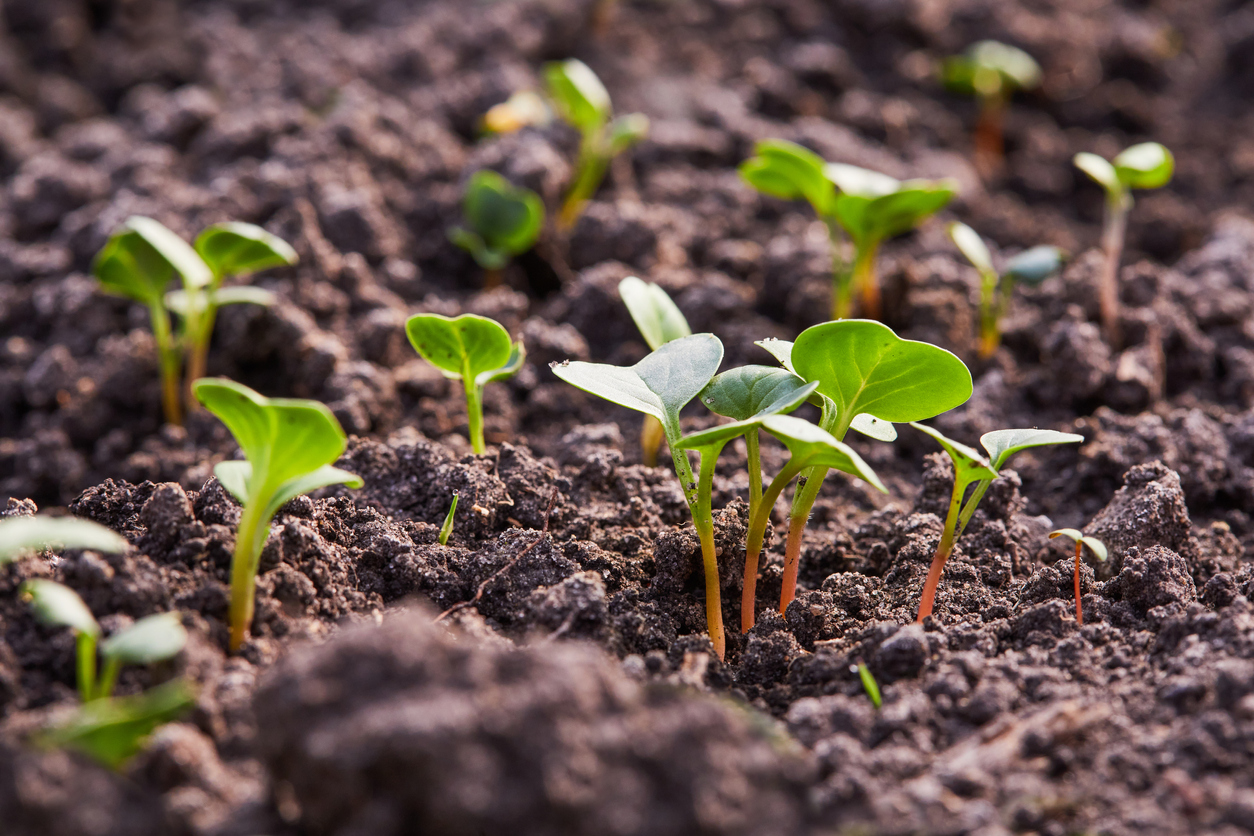
Young radish sprouts growing in the soil
Planting
Radishes can be planted directly in the ground or in raised beds, four to six weeks before the last frost.
The benefit of growing directly in soil is that you have more room to work with than in a raised bed or container, and you’re less likely to get root rot because the soil has space to breathe.
Wherever you plant your seeds, keep the area free of weeds and grasses, because they will compete for nutrients that radishes need.
Also consider the sun they desire. In the spring and fall they want full sunlight, but in the summer they prefer full or part shade.
Plant Spacing
Plant seeds about 1 inch between each seed, at a shallow depth of about 1/4 to 1/2 inch deep. If you are planting radishes of the larger variety like many winter daikon radishes, plant seeds 1 inch deep and 4 to 6 inches apart. In terms of row spacing, for small radishes, plant 8 to 12 inches apart and for larger winter or daikon radishes, plant 12 to 16 inches apart.
Cover loosely with soil, and mist to moisten the soil. Radish seeds are very small, so be careful not to water them away.
Radish seeds should germinate within 10 days. When your plants are a few inches tall, you should thin them out, or remove the extra plants.
If you are having a particularly rainy season, one heavy rain is all it will take to wash your seeds away. Some gardeners put down a plank of untreated wood on top of their seed rows to protect the seeds from excess water. It also helps retain moisture. A row cover serves the same purpose; just make sure all the edges are weighted down to the ground. Remove the covers between five and 10 days after planting to check on the germination process and (hopefully) give your sprouts the sunlight they need to start growing.
Succession Planting and Crop Rotation
If you’d like to have a continuous radish crop, try succession planting: plant a new row of seeds every two or three weeks so you never run out of radishes. Try planting a different variety each time. It’s a great way to sample new varieties of radishes.
If that feels like too much work, try planting in late spring for a summer crop, and again in late summer (if it’s cool enough) for a fall crop before your region’s hard frost date. If you’re planting winter varietals, keep in mind that they take eight to nine weeks before they’re ready to harvest.
Another consideration is using radishes as a cover crop. In commercial farming, radishes are sown and used to improve compacted soil over the winter.
As for crop rotation, a three-year crop rotation is good for pretty much all crops. It allows the soil to be enriched and replenished by other plants. For example, legumes and pod crops will always fix the nutrients in the soil that Brassicas deplete, so you want to plant beans after radishes.
Typically, in the case of radishes, because they are so small and can be spread out in small batches, there is no huge need to rotate these crops. However, if you are truly planting a bed of radishes, it would certainly deplete the nutrients in that bed. But if radishes are accessories to your beds with larger crops like tomatoes, you should follow the succession of that specific plant.
Companion Planting

Radishes, carrots, leeks, chard, lettucem and spinach growing together in a raised bed
Companion planting can serve several purposes. You can choose plants to help repel pests to protect your main crop; you can plant something like nasturtiums to attract aphids so they don’t attack your radishes; and you can plant companion plants to help you remember where you planted your radishes.
Because radish seeds are so small and germinate so quickly, you can plant radishes along with your carrots, which have a much longer germination time, if only to help you mark the rows for your carrots. Of course, you could also use row markers—but you can eat the radishes!
Radishes are actually the heroes of the garden and are companions to many. For example, they attract flea beetles and aphids away from peppers, squash, and other vegetables, so they can be grown as a “trap crop”—meaning they are grown not to eat but to help other plants.
Like other Brassicas, radishes release natural weed suppressing chemicals as they decompose.
Radishes also help other plants by breaking up the soil and enhancing soil percolation, allowing root systems to expand. Good companion plants for radishes include:
- carrots
- lettuce
- spinach
- dill
- tomatoes
- peppers
- cucumbers
- peas
You can see all of our companion planting suggestions in our Companion Planting Chart. Print it out and keep it handy when you’re planning your garden!
Raised beds
Raised beds are perfectly wonderful for growing radishes.
Watering and weeding will be easier if you have your radishes in a raised bed or planter and it’s a good alternative to growing in open land.
But the real benefit to growing radishes in raised beds is that if you fill a raised bed with packaged garden soil, you know you’re providing a cleaner and healthier environment for your radish plants from the outset and providing room for the roots to grow.
Additionally, raised beds dry out quicker than if you planted directly into the earth, which is beneficial in preventing root rot from too-moist soil.
How do you plant your radishes? What criteria for site selection has worked for you? Please share your ideas with us.


 Previous
Previous

